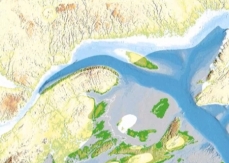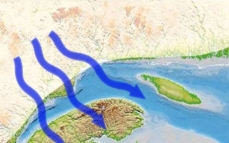Transcription of video clip Species in movement
Colonizing the land in the Gulf of St. Lawrence

© John Shaw, Geological Survey of Canada
The lands are covered by an ice sheet.
13,000 years ago, the Earth was deep in a glacial period. Québec was covered with a thick continental glacier, an ice sheet.
But the planetary winter was drawing to a close. The planet warmed again, and little by little the glaciers retreated to the poles.
However, the Gaspé glacier still blocked part of the passage toward the land to the north already free of ice.

© Jardin botanique de MontrĂ©al
The climate is unfavorable.
A thousand years later, conditions were still unfavorable.
Cold winds blew toward Anticosti and the Gaspé Peninsula.
They maintained a cold climate and pushed tree seeds southward.
This was the herbaceous tundra domain.

© Jardin botanique de MontrĂ©al
The climate is still very cold.
10,000 years ago, spruce and green alder colonized the Gaspé Peninsula.
But meltwater from glacier lakes that flowed along the St. Lawrence toward the Atlantic cooled the regional climate once again.
Spruce retreated toward the south; only green alder, a hardy shrub, persisted.
The green alder then found its way to Anticosti.
The soil freed up there by the receding ice was poor and thin.
The shrub was nonetheless able to colonize this ground, thanks to a symbiosis with nitrogen fixing bacteria.
The alder also took advantage of the minimal presence of other trees.
Spruces also reached Anticosti.
But since they were at the northern limit of their growth zone, alders continued to dominate the vegetation.
8,000 years ago, balsam fir in turn seeded Anticosti.
The first forests, still very open, began to form.
Spruce, balsam fir and green alder shared Anticosti, and even colonized the Sept-Iles region.
6,000 years ago, Anticosti was covered in closed forest.
Green alders, that needed light, were supplanted.
In the Sept-Iles region, firs, which grow in fertile soil, in turn disappeared.
Abundant rains that washed away nutrients from the ground were probably to blame.
In the Gaspé Peninsula, the contrary occurred: firs took advantage of the favorable climate to become dominant.
Throughout history, trees migrated this way, following environmental fluctuations.
Note how green alder, those early pioneers, took advantage of the disappearance of spruce to resettle in the Gaspé Peninsula!
Back to video clip




